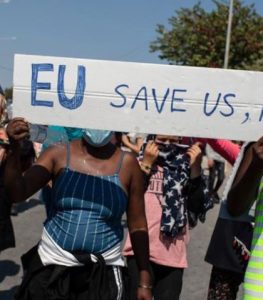EU called out over double standards on asylum seekers
The European Union has come under fire over ’double standards’ in the way in has treated Ukrainian refugees in comparison with people fleeing other conflicts.
Almost three months into Russia’s invasion of Ukraine, the European Union has welcomed more than four million Ukrainians by activating an existing but arcane piece of EU legislation that gives them immediate protection and the right to work.
 The Temporary Protection Directive (TPD), was designed for the mass arrival of refugees and has been allowing Ukrainians to sidestep the EU’s Byzantine asylum processes.
The Temporary Protection Directive (TPD), was designed for the mass arrival of refugees and has been allowing Ukrainians to sidestep the EU’s Byzantine asylum processes.
The EU’s use of the TPD in relations to Ukrainians has been widely praised but observers have pointed out how its recent use contrasts with how other groups of asylum seekers have been treated.
Director of the NGO the European Council on Refugees and Exiles Catherine Woollard says the contrast is stark.
“The TPD is a very different approach compared to what has been the strategy of the EU and many European countries for the last five years. That strategy is based on prevention of arrivals regardless of the costs or consequences,” Ms Woollard said.
Among these costs and consequences are the forced return of asylum seekers to circumstances where conflict is underway and human rights abuses.
Ms Woollard says deals struck with Turkey and Libya to prevent arrivals from making it to Europe have led to these abuses.
Without legally being able to find routes to Europe, last year, more than 3,000 people went missing or died sin transit – the highest number since 2016.
The war in Ukraine has seen the first use of the TPD mechanism even though human rights groups unsuccessfully lobbied for its use in 2015 to deal with the large numbers of Syrians arriving in Europe.
Refugee advocates say its use in the Ukraine crisis shows that Europe has the capacity to provide a better response to refugee crises.
They say that the often used excuse for blocking migrant – that there’s limited space and finance to take so many refugees – rings hollow.
Advocates says the response to Ukraine has shown that none of this holds true if there is a political will to respond.
While some observers say the proximity and scale of the Ukrainian displacement has made the invocation of the TPD necessary, the race and religion of those is also a factor
Human Rights Watch director Judith Sunderland said: “It really is important to reflect on how EU migration and asylum policies to date clearly have a disproportionate impact on black and brown people”.
Using the TPD also means that Ukrainian refugees in Europe, unlike people fleeing other conflicts, are not considered asylum seekers.
While there are differences in the way different groups of people fleeing persecution or conflict are treated in different parts of the EU, it is much worse in some countries.
Greece is increasingly pushing back asylum seekers into Turkey with the UNHCR recording almost 540 incidents of informal returns at Greece’s land and sea borders since the beginning of 2020.
Meanwhile, there have been 25 deaths and disappearances so far in 2022 of people trying to cross Turkey’s land border into Greece and Bulgaria.
Poland, which has received more than three 3 million Ukrainians, also has discouraged other asylum seekers from entering.
So far this year, Polish border guards apprehended and returned more than 4,000 people including Syrians, Afghans, Iraqis and Cubans who have attempted to cross over the border from Belarus.
In a recent statement, Amnesty International said: “We need to recognise that bombs are still falling on Ukraine and people are leaving desperate situations, so we need to support them. We also need to be challenging that double standard.”












